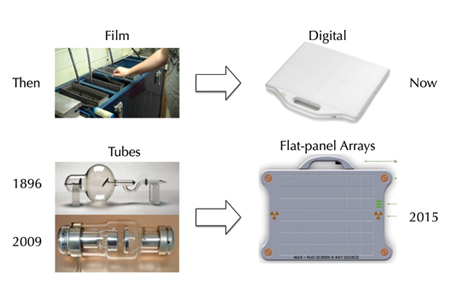Bringing Radiology And X-ray Imaging To The Wounded Warrior
By Mark Evans, Tom Carrell, Kristin Schmiedehausen, and Gil Travish
The evolution of X-ray imaging
 The simple 2D X-ray remains the staple of medical diagnostic imaging, even after over a century of technical and clinical development. While more advanced imaging modalities such as computer tomography (CT), magnetic resonance imaging (MRI), and positron emission tomography (PET) can offer the clinician enhanced diagnostic insights, these 3D imaging methods come at the expense of increased size and weight, preparation and acquisition time, complexity, and (often) radiation dose. So, planar radiology still offers the most rapid and simplest means of diagnosing a wide range of medical conditions and is often the first-line imaging technique in any type of emergency situation.
The simple 2D X-ray remains the staple of medical diagnostic imaging, even after over a century of technical and clinical development. While more advanced imaging modalities such as computer tomography (CT), magnetic resonance imaging (MRI), and positron emission tomography (PET) can offer the clinician enhanced diagnostic insights, these 3D imaging methods come at the expense of increased size and weight, preparation and acquisition time, complexity, and (often) radiation dose. So, planar radiology still offers the most rapid and simplest means of diagnosing a wide range of medical conditions and is often the first-line imaging technique in any type of emergency situation.
In a typical planar radiology system, X-rays are generated in a vacuum tube powered by a high voltage generator, which produces a cone of X-rays; it is effectively a point source. The X-ray source is typically big, heavy, and fragile. The X-rays traverse the patient, and the resulting attenuated beams are intercepted by a detector positioned directly behind the body part to be imaged. The transformation from the traditional X-ray film to digital detectors has occurred within the last two decades, which led to the elimination of process chemicals, time delays for developing, and to the arrival of nearly instantaneous image viewing, transmission, and storage. Now a similar transformation is set to occur for the X-ray source.
Get unlimited access to:
Enter your credentials below to log in. Not yet a member of Med Device Online? Subscribe today.
